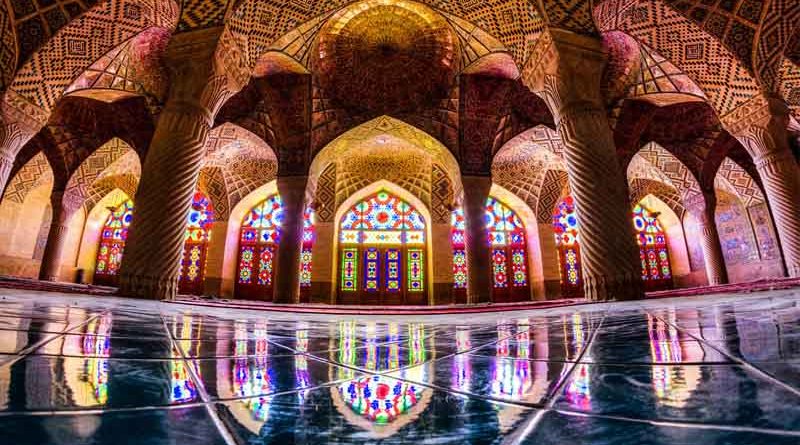Persepolis:
Persepolis was the capital of Achaemenid Empire (ca. 550–330 BC). It is situated 70 km northeast of the city of Shiraz in Fars Province, Iran. UNESCO declared the ruins of Persepolis a World Heritage Site in 1979.
This amazing Persian building is located on the slopes of Mount Rahmat or Mount Mehreh near Shiraz. The city was known as Pārsa or Persia of Persis or called Takht-e-Jamshid. Because Persians of Late Antiquity believed Jamshid, an Iranian mythological figure, built its monuments, since the time of the Sasanian period the site has been known as Takht-e-Jamshid, that means Throne of Jamshid.
The Persepolis complex consisted of palaces of the Achaemenid kings; it was built in 512 BC, on the orders of Darius the first of the great kings of the Achaemenid dynasty, and after him, Khashayar Shah, Darius’s son and Ardeshir I, grandson Dariush the First continued to build it. According to the documents contained in the inscriptions left from the ancient Iranian era.
The buildings at Persepolis have included three general groupings: military quarters, the treasury, and the reception halls and occasional houses for the King. It is noted that structures include the Great Stairway, the Gate of all Nations, the Apadana, the Hall of Hundred Columns, the Tripylon Hall and the Tachara, the Hadish Palace, the Palace of Ardeshir III, the Imperial Treasury, the Royal Stables, and the Chariot House.But the Apadana Palace is the heart of Persepolis
The Persepolis architecture used wooden columns. Column bases and capitals were made of stones, even on wooden shafts, but the existence of wooden capitals is probable. Only two columns of the building remained intact.
Apadana Palace:
The central part of the palace, due to its vast size, had the capacity of thousands.Also, 72 columns were responsible for maintaining the palace roof at a height of 25 meters from the floor of the building. It seems that the tablets are in a box and writings from Dariush on the borders of his country.According to Khashayar Shah, who you can see his statue on the stairs, it seems that the construction of the Apadana Palace had lasted nearly 30 years.
Darius I, built the greatest palace at Persepolis on the western side of the platform. This palace was called the Apadana. The King of Kings used it for official audiences. Its building was begun in 518 BC, and his son, Khashayar I, completed it 30 years later.
The palace had a grand hall in the shape of a square, each side 60 meters (200 ft) long with seventy-two columns, thirteen of which still stand on the enormous platform. Each column was 19 meters (62 ft) high with a square bull and plinth. The columns carried the weight of the vast and heavy ceiling.
The tops of the columns were made from animal sculptures such as two-headed lions, eagles, human beings and cows. Cows were symbols of fertility and abundance in ancient Iran. The walls were covered with a layer of mud and stucco to a depth of 5 cm, which was used for bonding and then covered with the greenish stucco which is found throughout the palaces
The construction of the Apadana Palace, which can be described as the heart of Persepolis, also began at the time of the construction of the Shah’s treasury. Due to the art, political history and architecture used by Apadana, it had dubbed the largest palace of Persepolis. It was also the first Persian stone mansion to be built from stones.
Oriental staircase:
According to a statement, stairs of two parties in the northwest were made by Khashayar Shah in Persepolis as the main entrance. According to historical writings, the first entry in the south gallery was built after the construction of the main staircase, as construction work.
Hadish Palace:
Hadish was called as the Palace of Khashayar for many years, but in 1979 this entry was proved that the start of construction of the palace during the reign of Darius but Khashayar completed it. Inside the palace, from the north to the south, a large indoor water was embedded in a part of the main hall, opened on it.
Stairs Hadish:
The palace, like other palaces built in the huge complex of Persepolis. Fortunately, the staircase is still intact. Western and Eastern Ghat has been refurbished in 1978 by experts and architects. The palace had 36 columns and a large courtyard in the southern part of the central hall of the palace.
Winged human:
The connection between the yard, the hall, and porch with 12 columns, was considered as one of the beauty and attractions of Hadish. Sadly, due to the persistent lack of stones used in the construction of the palace and sufficient endurance against fire and attack by Alexander the Great, most parts of the palace had been destroyed.
Harem or Queen’s House:
According to the historical content and ancient, it seems that the Harem palace had been built by Khashayar Shah.
Harem palace architecture and design and buildings next to each other were the same. In each of these building, there was a large room several small rooms. Depending on the type and design can be seen in the main hall, the introduction of these places as the far-fetched location was the queen’s residence. But the interpretation of this House as the place of women in the king’s life was not correct.
Gate of All Nations:
The Gate of All Nations, referring to subjects of the empire, consisted of a grand hall that was a square of approximately, with four columns and its entrance on the Western Wall. There were two more doors, one to the south which opened to the Apadana yard and the other open to a long road to the east.
The name of Khashayar I was written in three languages and carved on the entrances, informing everyone that he ordered it to be built. Small palace in the northeast of Persepolis was located in front of the entrance ramp.
A pair of lamassus, bulls with the heads of bearded men, stand by the western threshold. Another pair, with wings and a Persian Heads stand by the eastern entrance, to reflect the power of the empire.
The palace was named after a famous nation because of various representatives of entry into Persepolis purported that had been passed through it, to other parts of the palaces of Persepolis and took them inside. That is why the creators of Persepolis, Gate of All Nations built the magnificent and impressive grandeur, was the manifestation of the power and glory of the Achaemenid rule. The building according to the command of Khashayar and for a relatively small lounge, 3 and 4 columns, every 5 m and 16 cm in height, was built In the center of the hall, you can see traces of the remains of a table. In addition, the inscription inside the hall, which in Persian, Elamite, and Babylonian engraved, another interesting and surprising is the Gate of All Nations.
The Throne Hall:
Next, to the Apadana, second largest building of the Terrace and the final edifices, there was the Throne Hall or the Imperial Army’s Hall of Honor, also called the Hundred–Columns Palac. At the beginning of the reign of Khashayar I, the Throne Hall was used mainly for receptions for military commanders and representatives of all the subject nations of the empire. Later, the Throne Hall served as an imperial museum.
Tomb of Persepolis:
It is commonly accepted that Cyrus the Great was buried in Pasargad, which was named as his own city. If it is true that the body of Cambyses II was brought home “to the Persians”, his burying place must be somewhere beside that of his father. It is said that it was the custom for a king to prepare his own tomb during his lifetime. Hence, the kings buried at Naghsh-e Rostam are probably Darius I, Khashayar I, Ardeshir I and Darius II.
Khashayar II, who reigned for a very short time, could scarcely be obtained so splendid a monument, and still, less could the usurper Sogdianus. The two completed graves behind the compound at Persepolis would then belong to Ardeshir II and Ardeshir III.
The unfinished tomb, a kilometer away from the city, perhaps belongs to Ardeshir IV, who reigned at the longest two years, or, if not his, then that would be of Darius III, who is one of those whose bodies are said to have been brought “to the Persians”. Since Alexander the Great is said to have buried Darius III at Persepolis, then it is likely the unfinished tomb is his. Another small group of ruins in the same style was found at the village of Haji Abad, on the Pulvar River, is a good hour walk above Persepolis.

